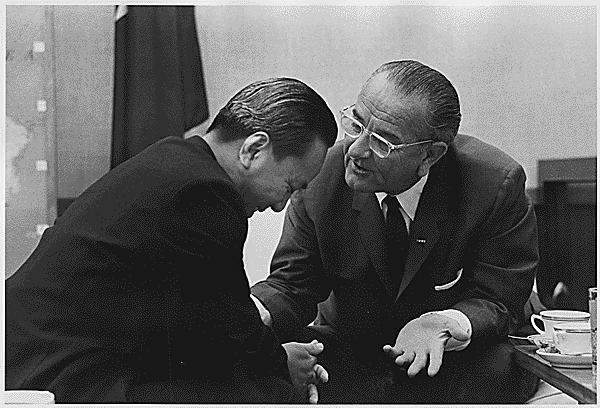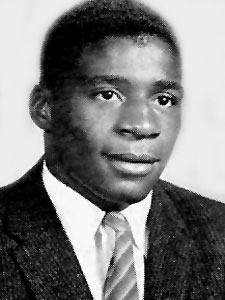Watts v. United States – True Threat Test – 1st Amendment
In Watts v. United States, 394 U.S. 705 (1969), the Supreme Court held, without the benefit of oral argument, that the First Amendment does not protect true threats. The Court also explained that political hyperbole does not qualify as such a threat.
‘If they ever make me carry a rifle the first man I want to get in my sights is L.B.J.’
In August 1966, an 18-year-old African American war protestor, Robert Watts, attended an anti-war rally at the Washington Monument. During a small discussion group designed to discuss the problem of police brutality, Watts allegedly said: “They always holler at us to get an education. And now I have already received my draft classification as 1-A and I have got to report for my physical this Monday coming. I am not going. If they ever make me carry a rifle the first man I want to get in my sights is L.B.J. . . .They are not going to make me kill my black brothers.”
An investigator for the Army Counter Intelligence Corps overheard Watts’s intemperate remarks, which led to his arrest for violating a federal law prohibiting threats against the president. A federal jury convicted Watts of violating the statute, and a divided District of Columbia Circuit Court of Appeals affirmed.
Court said anti-war protester’s threat was crude political hyperbole
On further appeal, the Supreme Court reversed in a 5-4 per curiam opinion. The majority determined that the federal statute prohibiting threats against the president was constitutional and that true threats receive no First Amendment protection.
However, the majority also determined that Watts’s crude statements were political hyperbole rather than true threats. “What is a threat must be distinguished from what is constitutionally protected speech,” the majority wrote. “The language of the political arena … is often vituperative, abusive, and inexact.”
The Court agreed with Watts’s counsel’s characterization of Watts’s speech as “a kind of very crude offensive method of stating a political opposition to the President” that did not qualify as a true threat.
Justice William O. Douglas concurred in an opinion that would have gone further than the per curiam majority opinion and invalidated the federal statute. “Suppression of speech as an effective police measure is an old, old device, outlawed by our Constitution,” he concluded. Justice Abe Fortas, joined by John Marshall Harlan, dissented in a very short opinion questioning whether the Court should have taken the case.
Watts factors used in separating true threats from speech protected by First Amendment
Watts remains an important decision for First Amendment jurisprudence because it stands for the principle that true threats are not protected expression. The Watts factors are the three factors used by the Court in separating free speech from true threats.
Unfortunately, in Watts the Court did not establish a clear definition of what speech constitutes a true threat, leaving the lower courts to develop different tests.
David L. Hudson, Jr. is a law professor at Belmont who publishes widely on First Amendment topics. He is the author of a 12-lecture audio course on the First Amendment entitled Freedom of Speech: Understanding the First Amendment (Now You Know Media, 2018). He also is the author of many First Amendment books, including The First Amendment: Freedom of Speech (Thomson Reuters, 2012) and Freedom of Speech: Documents Decoded (ABC-CLIO, 2017). This article was originally published in 2009.
cited https://mtsu.edu/first-amendment/article/707/watts-v-united-states
3 Prong Obscenity Test
The Watts factors refers to three factors the U.S. Supreme Court identified in its initial true-threat decision
Watts Factors
The Watts factors refers to three factors the U.S. Supreme Court identified in its initial true-threat decision Watts v. United States (1969) to distinguish between protected speech and a true threat.
3 factors in separating true threats from free speech
The three factors identified by the Court in Watts include:
- the context of the statement or statements in question;
- the reaction of the recipient or listeners; and
- whether the threat was conditional.
In Watts, federal authorities charged young, African-American protestor Robert Watts with violating a federal threat law criminalizing threats against the President.

Supreme Court: Anti-war comments were political hyperbole,
protected by First Amendment
At an anti-war rally, Watts allegedly said: “They always holler at us to get an education. And now I have already received my draft classification as 1-A and I have got to report for my physical this Monday coming. I am not going. If they ever make me carry a rifle the first man I want to get in my sights is L.B.J. They are not going to make me kill my black brothers.”
Watts’ reference to L.B.J. referred to then-U.S. President Lyndon Baines Johnson. Lower courts upheld his conviction.
The Supreme Court, in a per curiam opinion, determined that Mr. Watts had engaged in a crude form of political hyperbole rather than utter a true threat. The Court identified what later came to be known as the Watts factors. These included that Watts made his statements during a political rally, that those who overhead his remarks laughed, and his statement was conditional rather than definitive.
Still today, some lower courts use the Watts factors to determine whether speech crosses the line into the realm of true threats.
David L. Hudson, Jr. is a law professor at Belmont who publishes widely on First Amendment topics. He is the author of a 12-lecture audio course on the First Amendment entitled Freedom of Speech: Understanding the First Amendment (Now You Know Media, 2018). He also is the author of many First Amendment books, including The First Amendment: Freedom of Speech (Thomson Reuters, 2012) and Freedom of Speech: Documents Decoded (ABC-CLIO, 2017). This article was originally published in 2017.
cited https://mtsu.edu/first-amendment/article/1525/watts-factors
Watts Factors
The Watts factors refers to three factors the U.S. Supreme Court identified in its initial true-threat decision Watts v. United States (1969) to distinguish between protected speech and a true threat.
3 factors in separating true threats from free speech
The three factors identified by the Court in Watts include:
- the context of the statement or statements in question;
- the reaction of the recipient or listeners; and
- whether the threat was conditional.
In Watts, federal authorities charged young, African-American protestor Robert Watts with violating a federal threat law criminalizing threats against the President.
Supreme Court: Anti-war comments were political hyperbole, protected by First Amendment
At an anti-war rally, Watts allegedly said: “They always holler at us to get an education. And now I have already received my draft classification as 1-A and I have got to report for my physical this Monday coming. I am not going. If they ever make me carry a rifle the first man I want to get in my sights is L.B.J. They are not going to make me kill my black brothers.”
Watts’ reference to L.B.J. referred to then-U.S. President Lyndon Baines Johnson. Lower courts upheld his conviction.
The Supreme Court, in a per curiam opinion, determined that Mr. Watts had engaged in a crude form of political hyperbole rather than utter a true threat. The Court identified what later came to be known as the Watts factors. These included that Watts made his statements during a political rally, that those who overhead his remarks laughed, and his statement was conditional rather than definitive.
Still today, some lower courts use the Watts factors to determine whether speech crosses the line into the realm of true threats.
David L. Hudson, Jr. is a law professor at Belmont who publishes widely on First Amendment topics. He is the author of a 12-lecture audio course on the First Amendment entitled Freedom of Speech: Understanding the First Amendment (Now You Know Media, 2018). He also is the author of many First Amendment books, including The First Amendment: Freedom of Speech (Thomson Reuters, 2012) and Freedom of Speech: Documents Decoded (ABC-CLIO, 2017). This article was originally published in 2017.
To Learn More…. Read MORE Below and click the links
Learn More About True Threats Here below….
We also have the The Brandenburg v. Ohio (1969) – 1st Amendment
CURRENT TEST = We also have the The ‘Brandenburg test’ for incitement to violence – 1st Amendment
We also have the The Incitement to Imminent Lawless Action Test– 1st Amendment
We also have the True Threats – Virginia v. Black is most comprehensive Supreme Court definition – 1st Amendment
We also have the Watts v. United States – True Threat Test – 1st Amendment
We also have theClear and Present Danger Test – 1st Amendment
We also have theGravity of the Evil Test – 1st Amendment
We also have the Elonis v. United States (2015) – Threats – 1st Amendment
Learn More About What is Obscene….
We also have the Miller v. California – 3 Prong Obscenity Test (Miller Test) – 1st Amendment
We also have the Obscenity and Pornography – 1st Amendment
Learn More About Police, The Government Officials and You….
We also have theBrayshaw v. City of Tallahassee – 1st Amendment – Posting Police Address
We also have thePublius v. Boyer-Vine –1st Amendment – Posting Police Address
We also have the Lozman v. City of Riviera Beach, Florida (2018) – 1st Amendment – Retaliatory Police Arrests
We also have the Nieves v. Bartlett (2019) – 1st Amendment – Retaliatory Police Arrests
We also have the Freedom of the Press – Flyers, Newspaper, Leaflets, Peaceful Assembly – 1st Amendment
We also have the Insulting letters to politician’s home are constitutionally protected, unless they are ‘true threats’ – 1st Amendment
We also have the Introducing TEXT & EMAILDigital Evidencein California Courts – 1st Amendment
We also have the First Amendment Encyclopedia very comprehensive – 1st Amendment
ARE PEOPLE LYING ON YOU? CAN YOU PROVE IT? IF YES…. THEN YOU ARE IN LUCK!
We also have the Penal Code 118 PC – California Penalty of “Perjury” Law
We also have theFederal Perjury – Definition by Law
We also have the Penal Code 132 PC – Offering False Evidence
We also have the Penal Code 134 PC – Preparing False Evidence
We also have thePenal Code 118.1 PC – Police Officers Filing False Reports
We also have the Spencer v. Peters– Police Fabrication of Evidence – 14th Amendment
We also have the Penal Code 148.5 PC – Making a False Police Report in California
We also have the Penal Code 115 PC – Filing a False Document in California
Know Your Rights Click Here (must read!)
Under 42 U.S.C. $ection 1983 – Recoverable Damage$
42 U.S. Code § 1983– Civil Action for Deprivation of Right$
$ection 1983 Lawsuit – How to Bring a Civil Rights Claim
18 U.S. Code § 242 – Deprivation of Right$ Under Color of Law
18 U.S. Code § 241 – Conspiracy against Right$
$uing for Misconduct – Know More of Your Right$
Police Misconduct in California – How to Bring a Lawsuit
New Supreme Court Ruling – makes it easier to sue police
RELATIONSHIPWITH YOURCHILDREN& YOURCONSTITUIONAL RIGHT$ + RULING$
YOU CANNOT GET BACK TIME BUT YOU CAN HIT THOSE PUNKS WHERE THEY WILL FEEL YOU = THEIR BANK
We also have the 9.3 Section 1983 Claim Against Defendant as (Individuals) — 14th Amendment thisCODE PROTECTS all US CITIZENS
We also have the Amdt5.4.5.6.2 – Parental and Children’s Rights 5th Amendment thisCODE PROTECTS all US CITIZENS
We also have the 9.32 – Interference with Parent / Child Relationship – 14th Amendment thisCODE PROTECTS all US CITIZENS
We also have the California Civil Code Section 52.1Interference with exercise or enjoyment of individual rights
We also have the Parent’s Rights & Children’s Bill of RightsSCOTUS RULINGS FOR YOUR PARENT RIGHTS
We also have a SEARCH of our site for all articles relatingfor PARENTS RIGHTS Help!
Contesting / Appeal an Order / Judgment / Charge
Options to Appealing– Fighting A Judgment Without Filing An Appeal Settlement Or Mediation
Cal. Code Civ. Proc. § 1008 Motion to Reconsider
Penal Code 1385 – Dismissal of the Action for Want of Prosecution or Otherwise
Penal Code 1538.5 – Motion To Suppress Evidence in a California Criminal Case
CACI No. 1501 – Wrongful Use of Civil Proceedings
Penal Code “995 Motions” in California – Motion to Dismiss
WIC § 700.1 – If Court Grants Motion to Suppress as Evidence
 Epic Criminal / Civil Rights SCOTUS Help – Click Here
Epic Criminal / Civil Rights SCOTUS Help – Click Here
 Epic Parents SCOTUS Ruling – Parental Rights Help – Click Here
Epic Parents SCOTUS Ruling – Parental Rights Help – Click Here


